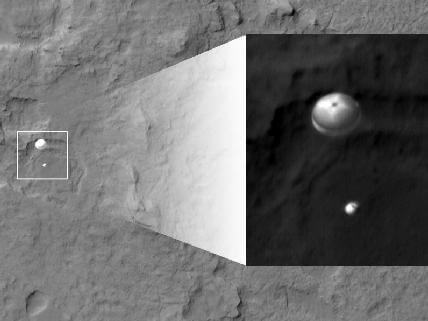Speaking to Universe Today, one of the senior engineers who planned the shot said that the MSL navigation team, the MRO navigation team and the MRO engineering team did some serious coordination work and the image was made possible by the careful planning of both teams

The crew of the HiRISE camera, which is aboard the MRO spacecraft orbiting Mars, surpassed itself today. Using their amazing device - Resolution Imaging Science Experiment - a high-resolution camera that is used these days as a fix for photographing the surface of Mars, they were able to photograph the Curiosity vehicle during its descent into the Martian atmosphere.
"We were able to focus on it" wrote Christian Schaller from the Hyrise team on the @MarsCuriosity account. The spacecraft looks great, he added.
Speaking to Universe Today, Schaller said that the MSL navigation team, the MRO navigation team and the MRO engineering team did some serious coordination work and the image was made possible by the careful planning of both teams.
Schaller is the software developer responsible for MRO's main planning tools, including Hirise and serves as a focused expert and member of the scientific team that planned the shot.
"The Martian soil in the background looks a little smeared because we timed it to capture Curiosity, and not photograph the surface," Shaler writes in an email interview after the photo was released at a press conference held at JPL.
The image was intended to capture the moments of MSL's descent. MRO personnel photographed the field of view along the spacecraft's expected descent path. "We were almost directly above the landing spacecraft, and we had a very small angle to photograph." Says Highrise team member Sara Malkowitz at the press conference. "MRO was above the deafening scene."
Before the landing, the chief researcher of the Highrise, Alfred McQueen, said that before the landing, the estimate was that the chance of the success of the photo would be about 60%.
Captioning the photo on the MRO website, McQueen added: "The parachute appears in the photo to be fully open and functioning well. The small details in the parachute such as the gap in the straps at the ends and the central hole are clearly visible. The wires connecting the parachute to the spaceship cannot be seen, although they did appear in the image of the Phoenix landing, it is possible that the reason why they could not be seen this time is due to the lighting angle.
The bright spot in the payload section of the parachute containing MSL-Curiosity may be a spectacular reflection of a bright area. MSL was released from the parachute shortly after the photo was taken.
This image is just one of the products from the aimed spread of the Highrise towards the estimated MSL position about a minute before landing. It was photographed by the CCD array at the relative end of the image, meaning that the spacecraft was located to the east or at a lower altitude than expected. The scale of the image is 33.6 centimeters per pixel.
MRO was 340 kilometers from Curiosity when the image was taken. "Hyrise also took over 120 images of Gale Crater in preparation for the MSL mission, but I believe this is the loudest of them all," she said.
Malkovich said that the HighRise team plans to photograph Curiosity when it is located on the surface of Mars later this week, with an even higher resolution photograph than the one taken during the descent.
In this film, the method used to photograph Curiosity is described in a simulation.

7 תגובות
http://www.nasa.gov/multimedia/imagegallery/image_feature_2328.html
The resolution of all of the MARDI frames is reduced by a factor of eight in order for them to be promptly received on Earth during this early phase of the mission. Full resolution (1,600 by 1,200 pixel) images will be returned to Earth over the next several months as Curiosity begins its scientific exploration of Mars.
For everyone who complains about the quality of the photos coming from Curiosity..
Really, how did they not think of that???? Very, very lucky that at least the laws of physics were considered
I completely agree with Uri, one simple color camera that was installed in the crane and would have photographed the process of the vehicle's descent on the cables would have greatly enhanced the operation in terms of public opinion, it could have been a spectacular spectacle!!!
How did they not think of that??
2.5 billion dollars and barely 3 poor black and white photos...
A colorful HD video of the landing from the crane would have greatly enhanced the operation
and public opinion for future release of funds from the government to NASA.
Americans love movies more than anything.
Too bad
It's a real shame that they didn't manage to capture the moment when Curiosity activated its thrusters. They should have put cameras in every corner, it should have been a sight out of this world...
Wow this is so amazing!!! It's a shame they didn't take pictures of all the stages of the landing, it was just cool....